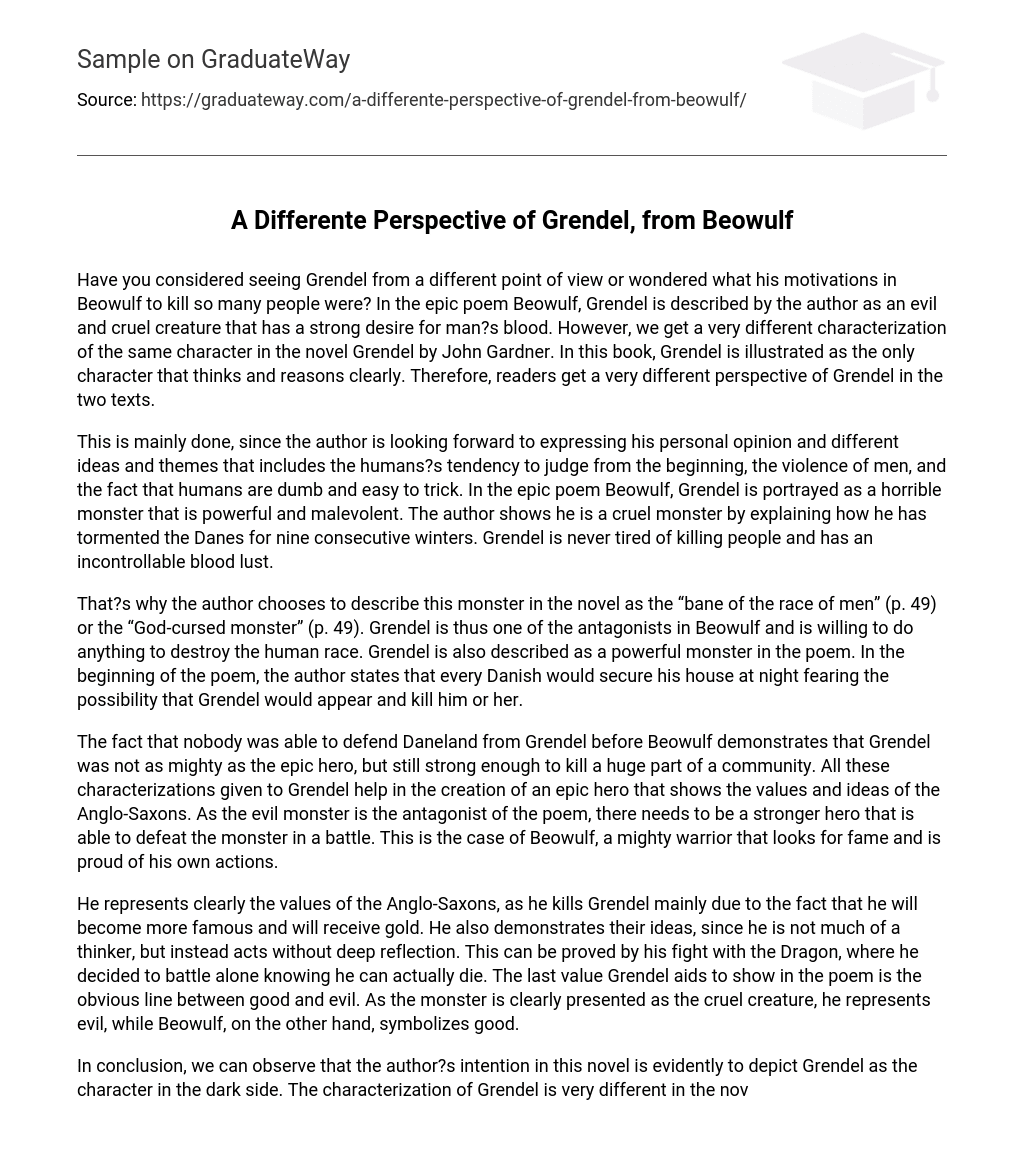Have you ever wondered about the alternative perspective on Grendel in Beowulf and his reasons for killing so many people? The epic poem describes him as a malevolent and vicious creature with an insatiable thirst for human blood. However, John Gardner’s novel Grendel presents a contrasting portrayal of the character. In this book, Grendel is depicted as the only individual capable of clear thinking and reasoning. Consequently, readers are presented with a distinct outlook on Grendel across the two texts.
In the epic poem Beowulf, the author discusses personal opinions and explores different ideas and themes such as humans’ tendency to judge prematurely, men’s violence, and humans’ gullibility. Grendel, a powerful and malevolent monster, is portrayed as a cruel creature who has been tormenting the Danes for nine consecutive winters. He constantly seeks to kill and has an insatiable appetite for blood.
Both the novel and Beowulf illustrate the monster as a threat to humanity. In the novel, it is referred to as the “bane of the race of men” (p. 49) and the “God-cursed monster” (p. 49), emphasizing its destructive nature. Similarly, in Beowulf, Grendel is portrayed as an adversary with a strong desire to eliminate humans. The poem describes Grendel as a formidable and powerful being. It mentions that every Dane would safeguard their homes at night due to fear of Grendel’s potential harm.
Despite not being as powerful as the epic hero, Grendel’s ability to cause significant devastation in Daneland before Beowulf’s arrival suggests that he still possessed enough strength to eliminate a considerable portion of the community. These portrayals of Grendel contribute to the depiction of an epic hero who embodies the values and beliefs of the Anglo-Saxons. As the antagonist of the poem, this malevolent creature necessitates a stronger hero who can defeat it in combat. Beowulf, driven by his desire for pride and fame, fulfills this crucial role.
The text emphasizes how Beowulf represents the cultural values of the Anglo-Saxons. He seeks fame and wealth when he kills Grendel. Furthermore, Beowulf acts on instinct rather than deep thought, as seen in his choice to confront the Dragon alone despite knowing the possible outcomes. The poem also highlights a clear contrast between good and evil, with Grendel representing cruelty and evil, while Beowulf embodies goodness and righteousness.
The author’s purpose in the novel Grendel is to depict Grendel as a dark character, contrasting with the peaceful and intelligent outcast portrayed in Beowulf. In this version of Grendel, he desires acceptance and socialization with people, unlike the violent and dangerous depiction in Beowulf. Additionally, the character is shown to possess intelligence.
Contrary to the portrayal in the epic poem, Grendel is not shown as a mindless monster solely driven by a desire to devour humans; instead, he is depicted as an intellectual thinker who approaches situations with depth and contemplation. Additionally, Grendel is the only one who recognizes how Hrothgar and the Shaper influence the thoughts of the men in Daneland, showcasing his unique ability to think critically and resist being deceived by the charming poet.
In addition, “Grendel” presents Grendel as experiencing feelings of sadness and loneliness, while “Beowulf” offers no exploration of his emotional state and portrays him as a thoughtless creature.
Despite his lack of social interaction, Grendel in Gardner’s novel experiences emotions like sadness and loneliness, leading to his strong desire to belong to the human community. These feelings highlight his uniqueness as a character embodying goodness. John Gardner deliberately presents an alternative depiction of Grendel in order to delve into various ideas and themes, which include showcasing men’s inclination towards violence and their tendency to pass judgments based on initial impressions.
The main message of this book is that humans often judge others based solely on their outward appearance, without taking the time to understand their true nature. This idea is shown in Gardner’s novel when Grendel tries to interact with people in the mead-hall. Despite his intention to socialize and start a conversation, the humans immediately see him as a dangerous creature. This proves that humans tend to make judgments about others based on initial impressions instead of uncovering their true emotions and personalities.
Gardner wants readers to see that humans possess a natural inclination towards violence. When people perceive Grendel as a malevolent monster, their immediate instinct is to launch an attack. They hurl spears at him and would have ended his life had he not managed to flee. Furthermore, the author demonstrates human aggression through Grendel’s discovery of a lifeless body in the forest. Grendel correctly deduces that the human’s demise resulted from their own violent tendencies. Additionally, Gardner illustrates how certain individuals are susceptible to manipulation.
The text highlights how all the Danes are deceived by the songs of the Shaper, while only Grendel can perceive the truth. Gardner’s rendition of Grendel serves to convey his ideas and expose certain human shortcomings. Consequently, Beowulf offers readers an authorial perspective on Grendel as a monstrous creature driven by violence and irrationality, eagerly anticipating the opportunity to harm others and willing to go to any lengths to achieve his goals.
In Gardner’s novel Grendel, Grendel is portrayed as being more intelligent than the majority of the Danes. Additionally, he is depicted as a peaceful creature whose main objective is to socialize with people. Gardner’s intention in presenting this different characterization is to highlight certain ideas that are often overlooked after reading Beowulf. Through Grendel, the author demonstrates that humans tend to judge based on first impressions and that we possess a propensity for violence. Furthermore, Gardner suggests that humans are easily manipulated. Ultimately, these contrasting depictions of the same character by two different authors serve the purpose of conveying a variety of ideas and themes.





